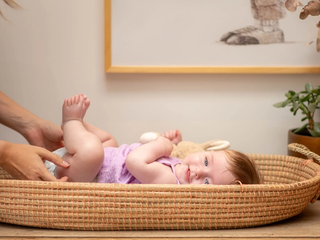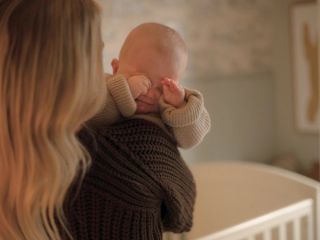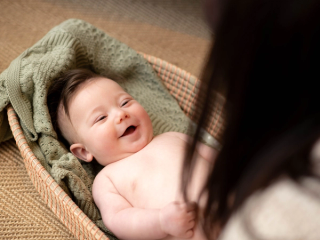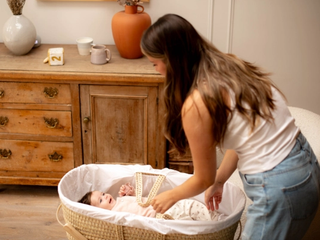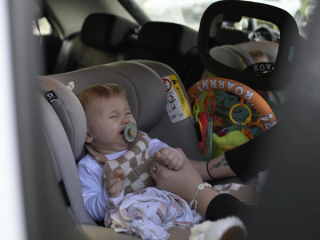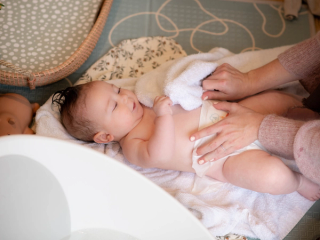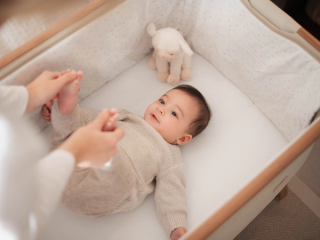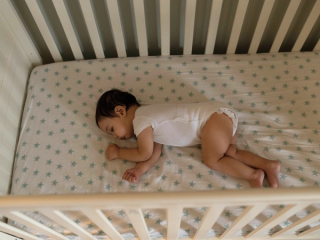
- Home
- Advice Hub
- Newborn
- Essential Newborn Care
- How Much Sleep Do Babies Need?
How Much Sleep Do Babies Need?
Learn about the essential sleep needs of babies at different stages, including tips for creating a soothing bedtime routine for better rest and development.
Maybe it feels like your baby doesn’t sleep much at all - but babies growing minds and bodies actually require quite a lot of sleep! Sleep aids their physical growth and dreaming allows your little one to store away the day's stimulating adventures so that they’re ready for all the exciting things that tomorrow may bring.
Baby Sleep Schedules and Routine
Does my baby need a sleep schedule?
A sleep schedule for your baby can be helpful for ensuring they get enough rest and for adding predictability to your day, but it doesn't need to be rigid. While newborns don't need a strict schedule due to their developing circadian rhythms, starting a flexible routine after 4 months can help balance daytime and nighttime sleep, preventing overtiredness.
When asking "How much sleep do children need? "It's helpful to consider their age. For example, a 6-month-old sleep schedule typically includes 10 to 12 hours of nighttime sleep and 2 naps of 1-2 hours each. A 5-month-old sleep schedule will have similar needs but might require slightly more sleep during the day.
As your baby grows, adjusting their schedule becomes important. For instance, an 8-month-old sleep schedule may involve about 10 to 12 hours of nighttime sleep and 2 naps, with the nap durations gradually reducing. Creating a consistent bedtime routine, including calming activities such as a bath or lullabies, can signal to your baby that it’s time to wind down.
Baby Sleep Needs Guide
Understanding how much sleep your baby needs at different stages can help in planning their schedule effectively. Below is a guide based on average sleep needs by age:
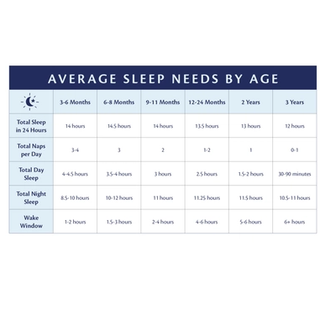
These sleep patterns help ensure that your baby’s sleep needs are met appropriately, reducing the risk of overtiredness or under-tiredness. Remember these timings are just a guide and every baby will need a slightly different routine depending on their temperament and your lifestyle. If you need help creating your perfect schedule my free ‘Sort Your Schedule’ mini course helps you do exactly that!
How can I tell if my baby is overtired or under-tired?
Determining whether your child is overtired or undertired can be challenging, as the signs can look quite similar. An overtired child may have difficulty settling, cry intensely, appear hyperactive, or wake frequently during the night. They might also experience short naps and early morning wakings.
In contrast, an undertired child might seem very alert at bedtime, push boundaries, and resist settling down. They could nap well but struggle with bedtime, take short naps, or wake frequently during the night.
To discern between the two, consider your child’s recent sleep patterns. If they've generally been sleeping well but now seem not tired enough, adjusting their nap schedule or bedtime might help. Conversely, if they've been having sleep troubles, overtiredness is likely. Start by experimenting with small adjustments to bedtime—moving it earlier for overtiredness or later for undertiredness—until you find the right balance.
How many naps per day does my baby need?
The 'average sleep needs by age' chart within this article outlines how many naps a baby of each age is likely to take per day, this will vary from child to child. For example, if your baby only takes very short naps, you may find you need more naps than the table suggests until your baby is able to extend their naps.
Your baby will also go through three major nap transitions throughout their first few years. Typically, the third afternoon nap drops sometime between 7-9 months, the morning nap will then drop sometime between 15-18 months of age and finally your toddler may be ready to reduce and drop their final lunchtime nap sometime between 2.5-3 years (although some children still need a short nap until 4 years!)
What are wake windows and how long should they be?
The chart also details average wake windows by age, which is the duration your baby can stay awake between sleep periods. Wake windows vary for a couple of reasons.
Firstly, they are generally shorter in the morning and longer in the evening. For example, the wake window between morning wake-up and the first nap of the day is usually the shortest, while the window between the last nap and bedtime is typically the longest.
Secondly, the chart provides a range for each age group; younger babies usually have shorter wake windows, while older babies can handle longer periods of wakefulness. Additionally, if the previous sleep was disturbed or shorter than usual, the following wake window may need to be shorter.
When planning your baby's schedule, aim to have them asleep by the end of their wake window. Be sure to account for the time needed to complete their nap or bedtime routine and allow some time for them to settle down.
Sleep Safety for Babies
Creating a safe sleep environment is essential to protect your baby from potential risks. Here are some guidelines to follow:
- Always place your baby on their back to sleep and ensure they are in the same room as you for at least the first six months.
- Keep the sleep space clear by removing bumpers, toys, and loose bedding from the cot, as these items can increase the risk of SIDS by covering the baby's head.
- Use a firm, flat, waterproof mattress to provide a safe sleeping environment.
- Maintain a smoke-free environment for your baby to further reduce the risk of SIDS.
- Prevent your baby from overheating by dressing them appropriately for the room temperature. Try to keep the room temperature between 16 -20°C.
- Sleep your baby in the same room as you for at least the first six months.
(Source: Lullaby Trust)
Safe Co-Sleeping
To reduce the risk of sudden infant death syndrome (SIDS), the safest place for a baby to sleep is in their own clear, flat, and separate sleep space, such as a cot or Moses basket. However, if you choose to co-sleep here is some guidance to do so as safely as possible.
When not to Co-Sleep:
- You or anyone in the bed has consumed alcohol recently.
- You or anyone in the bed smokes, or if the baby was exposed to smoking during pregnancy.
- You or anyone in the bed has taken drugs or medication that cause drowsiness.
- Your baby was born prematurely (before 37 weeks) or had a low birth weight (under 2.5 kg or 5½ lbs).
In these cases, it’s always safer to place your baby in their own sleep space, like a cot or Moses basket. Keeping this sleep space next to your bed can make nighttime easier.
Never fall asleep on a sofa or armchair with your baby, as the risk of SIDS is 50 times higher in this scenario. Additionally, there’s a significant risk of accidental death if the baby slips into a position where they can’t breathe.
Co-Sleeping More Safely
Adult beds are not designed or safety tested for infant sleep, unlike cots or Moses baskets. Whether you plan to bedshare or it happens unexpectedly, it’s crucial to prepare:
- Keep pillows, adult bedding, and any other items away from your baby to prevent their head from being covered or them overheating.
- Remove any slatted or decorated headboards.
- Follow all other safer sleep advice from The Lullaby Trust, such as always placing your baby on their back to sleep.
- Do not allow other children or pets into the bed, as this increases the risk of accidents.
- Ensure your baby cannot become trapped in the bed frame, headboard, or between the mattress and the wall, and that they cannot fall out of bed.
- Never leave your baby alone in an adult bed. Consider the risks that an adult bed may pose, especially as your baby becomes more mobile. Regularly check your bed setup to prevent possible accidents.
(Source: Lullaby Trust)
Disrupted Sleep
Disrupted sleep is common during a baby's first year as their sleep patterns are still developing. Newborns typically sleep in short cycles, waking frequently for feeding, comfort, or due to their immature circadian rhythm. As they grow, their sleep consolidates, but teething, growth spurts, or developmental milestones can lead to temporary sleep disturbances.
Sleep regressions, often occurring around 4, 8, and 12 months, are also common, where a baby who previously slept well suddenly begins waking more often. Parents can manage these disruptions by establishing a consistent bedtime routine and ensuring a soothing sleep environment.
It’s normal for babies to experience disrupted sleep. If your baby has trouble settling, wakes frequently, or is an early riser, remember:
- By 3-4 months: Some babies manage 5-6 hour stretches at night, but many do not.
- After 6 months: Night-waking occurs in 50% of children who previously slept through.
- By 9 months: 22% of babies have difficulty settling at night, and 42% wake frequently.
Understanding these patterns can help you manage expectations and seek support if needed.
How to Settle Your Baby
Settling your baby to sleep can be challenging, but there are effective strategies to help. Gentle rocking, using a soft chair or glider, mimics the womb’s motion and soothes the baby. White noise, such as from a fan or app, helps create a calming environment by masking other noises. Swaddling offers security by replicating the snug feeling of the womb, but ensures it’s done safely.
Establishing a consistent bedtime routine, like a bath and story, signals it's time to wind down. A cool, dark room with a firm mattress also promotes restful sleep. Lastly, gentle touch, like patting or rubbing, can provide extra comfort. Each baby is unique, so experiment to find what works best.
